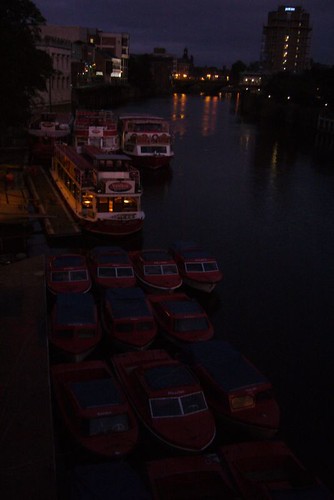Pictures across the curriculum: After the tourists have gone
In this article, English, Economics, culture, geography and tourism are highlighted.
Like most of the pictures I take, this one was unplanned. I saw all these boats in the evening, as I crossed over the bridge in York town centre. The scene struck me as rather poignant.
But then I got to thinking, it would make a great starting point for several avenues of study, such as:
 English
English
Why are the lights of one of the boats still on? What's going on there? What's the story, in other words?
Tourism
What is the role of tourism in general, and river trips in particular, in the life of the city? Are these things essential, or simply extras?
Economics
What sort of ancillary industries are you likely to find in the area? Presumably, there will be several trades associated with boats and rivers?
Culture/Geography
What part does the river play in York? In London, for example, the River Thames serves as a cultural as well as a geographical dividing line. The London south of the river is very different indeed to the London north of the river.
Local history
How has the city evolved over the centuries, and what part, if any, did the river play (or tourism, or the boat industry)?
I think you'll agree that this one photo could stimulate quite a bit of discussion, and be the starting point for a wide variety of projects.
What is there in your area that would make a photo with similar wide-ranging applications?
Before signing off this post, I'd like to draw your attention to a comment by Amran Nordin about my "Greyfriars" post. That was based on some pictures of the ruins of an abbey, and Amran said:
"I think students would need some guiding questions for them to get them started."
I think he is right, and that probably applies to all of these articles. For some students, or curriculum areas, more guidance will be needed than in others. It would be good if the students had access to a series of structured guidelines and/or questions to get them started and help them when they're stuck.
However, it does not follow from this that the teacher has to do all the work. Why not use part of a lesson to get the class itself to come up with a series of questions or steps?
Amran goes on to say:
I think it is quite hard for kids today to imagine what those ruins mean.
I think he may well be right, especially in areas where students would never have come across ruins in everyday life, or even on TV (unless they watch the History Channel). However, the issue can be resolved by recourse to the use of Ausubel's Advance Organizer concept, and in particular the principle of integrative reconciliation. This is a fancy way of describing what good teachers do all the time: relating new concepts to the student's existing knowledge.
The students themselves can play an active part in this process, through class discussion.
However you approach it, the interesting thing for me is that the use of a few well-chosen pictures can really open doors -- including a few that you may not even have known were there!
This article was originally published on the old ICT in Education website on 11th September 2008. If you found this article useful, you may also enjoy those found here: Photography